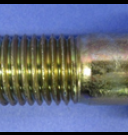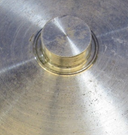The other day I was assisting a customer who had some questions about the Safety-Kleen model 6315 ultrasonic parts cleaner. They had a lot of questions about the machine. Upon further examination, what the customer wanted to know is how the ultrasonic cleaning process works - how exactly does this machine cleans parts.
To start with, the word ultrasonic means high frequency sound. The ultrasonic parts cleaner is sending power through a series of transducers. The transducers are made up of a series of ceramic disks that vibrate quickly. A typical ultrasonic parts cleaner will have several transducers attached to the cleaning tank. The micro vibrations from the ceramic disks create the high frequency sound waves that are sent through the cleaner and collide with the metal parts placed in the parts cleaner.
The really interesting, and effective, element with ultrasonic parts cleaners is what the ultrasonic waves do to the cleaning bath. As the ultrasonic waves move through the bath those waves are squeezing and pulling apart the cleaning solution. During the pulling apart portion of the ultrasonic wave the liquid of the cleaner is rarefied, meaning there are less liquid molecules in one space. In this rarefied area vacuum bubbles will form. The force that attracts the liquid molecules to each other doesn’t like this and are straining to close the void, but the wave is keeping them pulled apart.
Then the squeezing part of the wave moves through the cleaning bath. Not only is the cleaning solution no longer being pulled apart, it is being pushed into itself. The vacuum bubbles are slammed down in an implosion by the squeezing force of the ultrasonic wave, as well as the liquid molecules’ attractive forces for each other. This molecular attractive force is called the surface tension.
The implosion occurring in the cleaning bath is very energetic and powerful on a micro level. In the Safety-Kleen model 6315 ultrasonic parts cleaner, these sound waves are moving through the cleaning solution, causing implosions against the parts, at the rate of 40,000 times a second. It is these implosions that strip the soils off the parts.
The fact that ultrasonic parts cleaners are indeed using sound waves for cleaning also helps to explain why ultrasonic washers are not as effective at cleaning rubber and plastic parts. The sound waves have to vibrate. Materials that dampen sound waves, like rubber and plastic parts, actually steal the energy by absorbing the sound waves. Thus, this energy absorption dampens the overall effect of the implosions and reduces the ultrasonic sound waves’ ability to clean rubber and plastic parts.
All in all, ultrasonic parts cleaning is extremely effective in cleaning all kinds of metal parts. They do a great job on parts with blind holes, and inner chambers, that are hard to clean with traditional parts cleaning methods.
Ultimately, the customer was very appreciative of receiving more detailed information about ultrasonic parts cleaners and how they clean parts. I am confident they are going to buy an ultrasonic parts cleaner from Safety-Kleen in the very near future.




